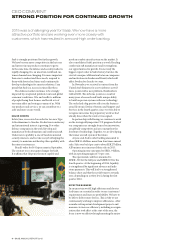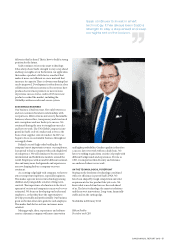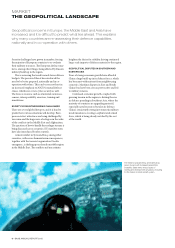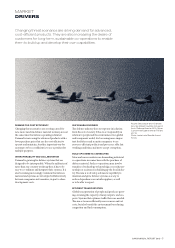Saab 2015 Annual Report Download - page 18
Download and view the complete annual report
Please find page 18 of the 2015 Saab annual report below. You can navigate through the pages in the report by either clicking on the pages listed below, or by using the keyword search tool below to find specific information within the annual report.
medium-sized orders. In some key markets with
a strong domestic defence industry, Saab can be
a subcontractor to a local company.
Suppliers in intergovernmental deals
Some large defence deals are arranged between
Sweden and another country. In these cases the
Swedish Defence Materiel Administration (FMV) is
the party that negotiates and signs the contract with
the customer country. Saab assists FMV in the sales
process, but only as a subcontractor to the Swedish
state. is relationship is most common in large
deals involving combat aircra systems or large
surveillance systems, for instance.
Research collaborations
Saab participates in broad-based innovation part-
nerships between industry, academia and the public
sector. Taking part in research collaborations is also
an element in Saab’s strategy to strengthen ties with
customers.
Diversity and integrative thinking drive innova-
tion, and the fact that Saab does research and devel-
opment work on several continents makes it more
competitive.
Corruption prevention
Saab has zero tolerance for corruption. is is
critical in order to be a reliable long-term business
partner. It is also a competitive advantage when
customers evaluate suppliers in an increasingly
open and transparent defence market.
Preventing corruption risks begins with current
laws, the company’s code of conduct, processes and
values as well as industry-wide codes of conduct.
Co-operations with marketing consultants is an
example of a business arrangement that entails an
increased risk, since the compensation is paid to
companies that are not under Saab’s direct control.
As a result, all such agreements must be evaluated
and approved by a central function within Saab –
Market Network Management.
Employees in at-risk groups such as marketing
and sales receive training in Saab’s code of conduct
and mandatory follow-up training covering, among
other things, general risk awareness, internal processes
and the company’s tools for managing corruption
risks.
All Saab employees are required to complete
web-based anti-corruption training.
STRATEGY
PROFITABLE GROWTH
SAAB’S MARKET
AREAS
To be close to customers in
key markets, Saab has
established five market areas:
• Nordic & Baltic
(incl. Poland)
• Europe, Middle East &
Africa
• North America
• Latin America
• Asia Pacific
TECHNOLOGY TRANSFERS
When Saab signs major defence contracts, they usually
involve more than just selling products. A growing
number of countries also want technology and skills
transfers as well as various forms of industrial co-oper-
ation. In this way, the buying country gets help building
up or strengthening its domestic defence industry.
The desire for technology transfers was a factor when
Brazil chose Gripen. The hope is that the co-operation
will help to further develop Brazil’s own defence industry.
Through Gripen, Brazil also has an opportunity to
participate in high-tech development with an extensive
international reach.
In total, around 350 Brazilian engineers and techni-
cians will spend time with Saab in Sweden, where they
will receive training by working together with Saab’s
employees on a number of projects. The training will
facilitate extensive development and production
work, including final assembly, of Gripen in Brazil. The
expertise that is built up in this way also gives Brazil
the domestic capability to maintain and upgrade Gripen.
The contract also contains research projects, which
bodes well for a close, long-term co-operation between
Sweden and Brazil.
For more information
on international
research collabora-
tions, see Saab’s
Sustainability Report.
14 – SAAB ANNUAL REPORT 2015
























